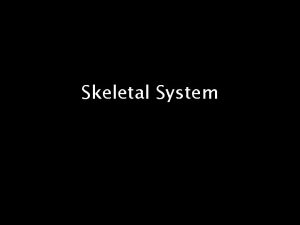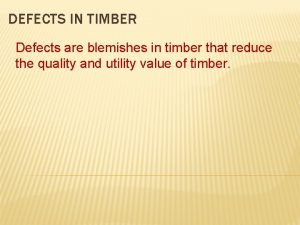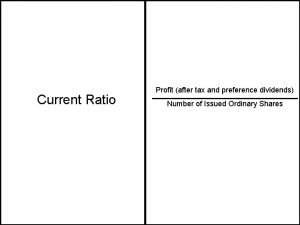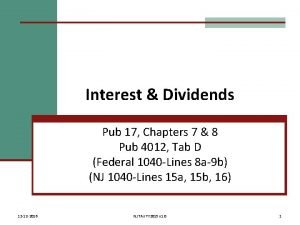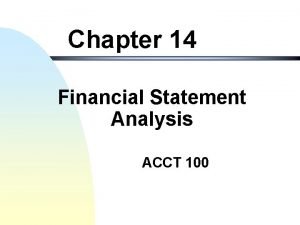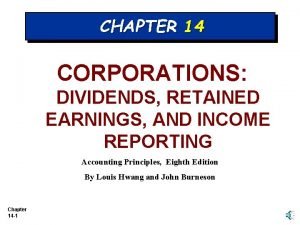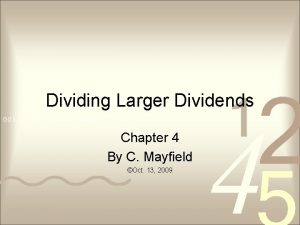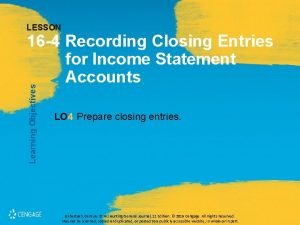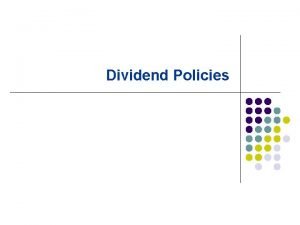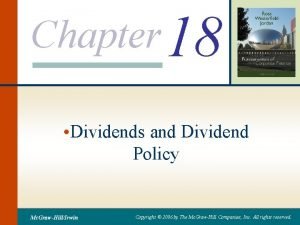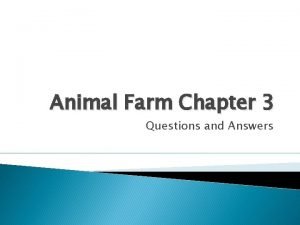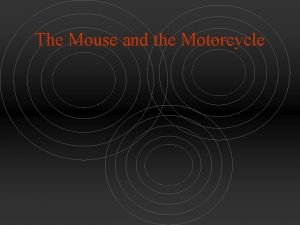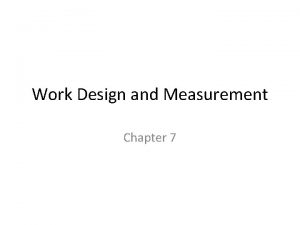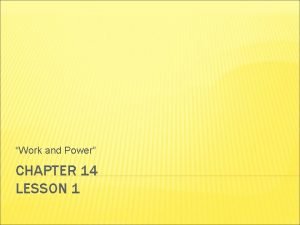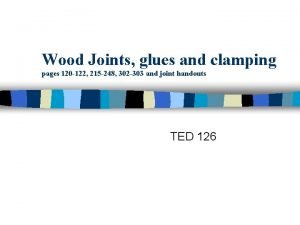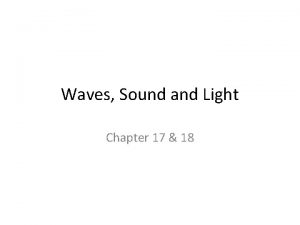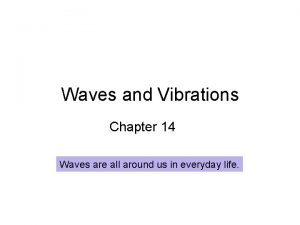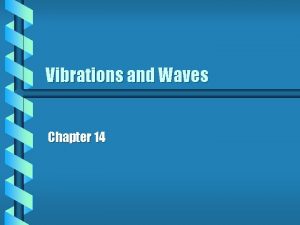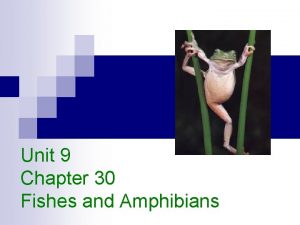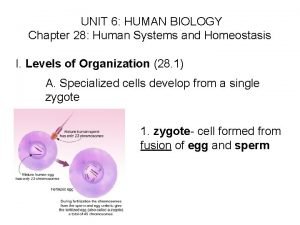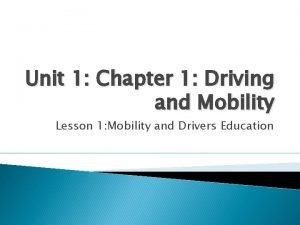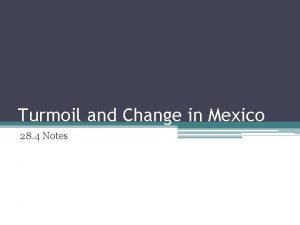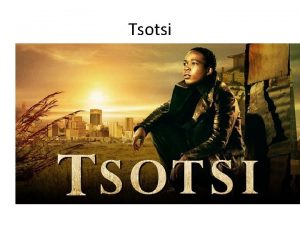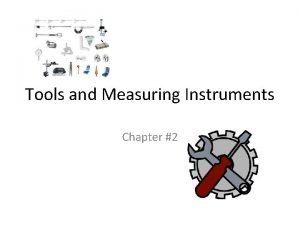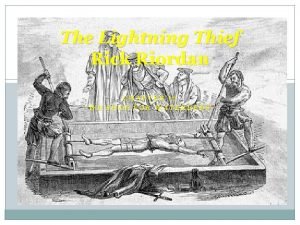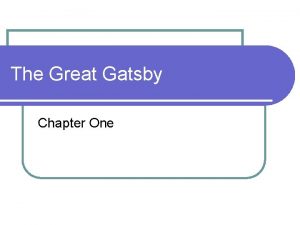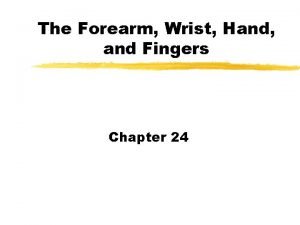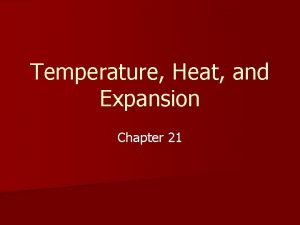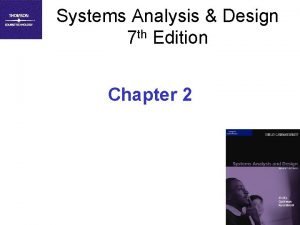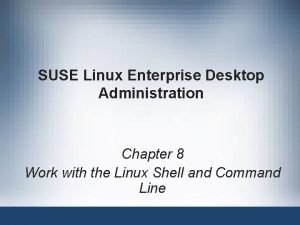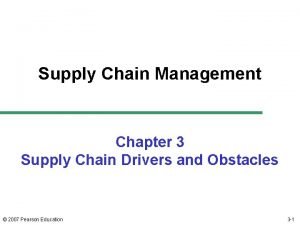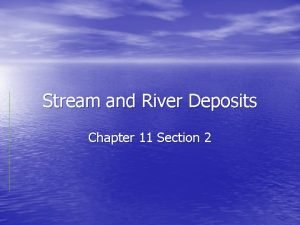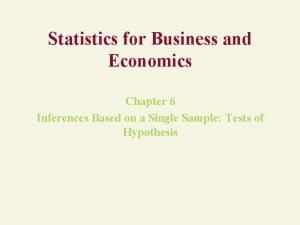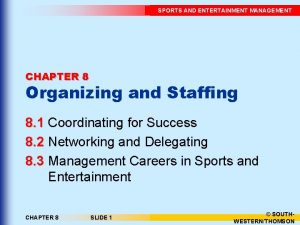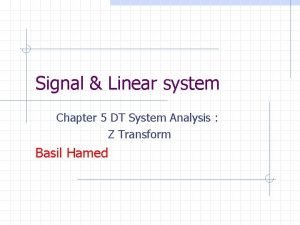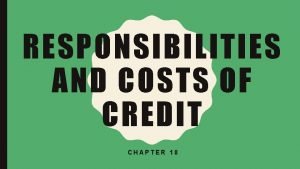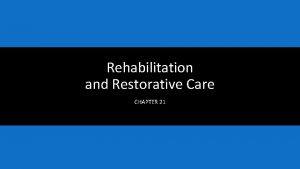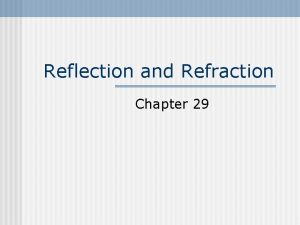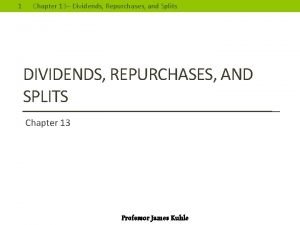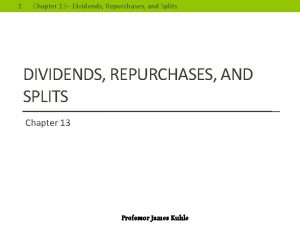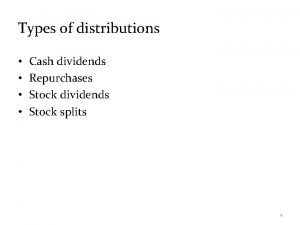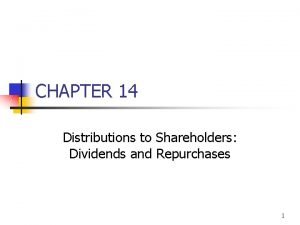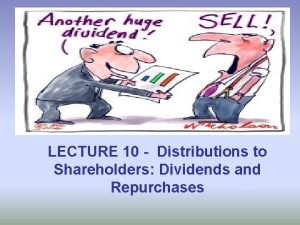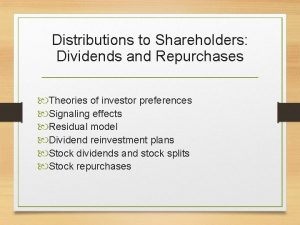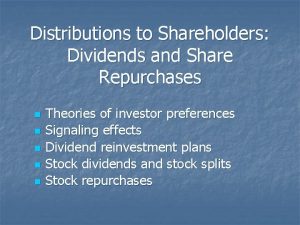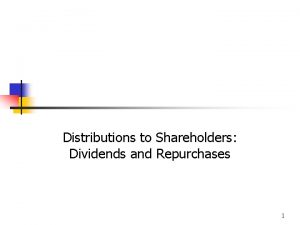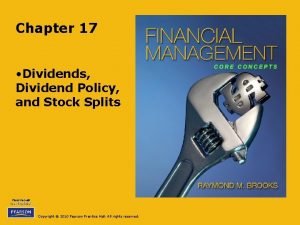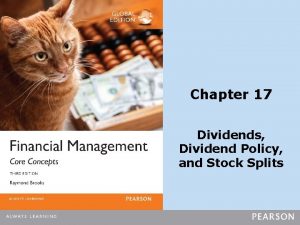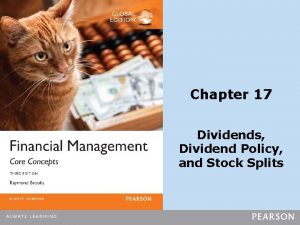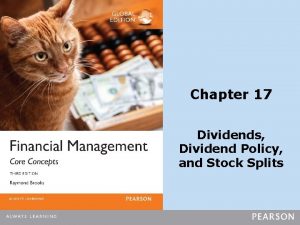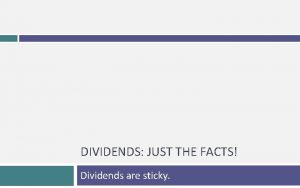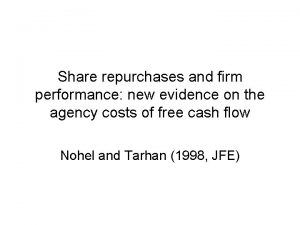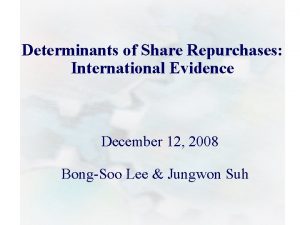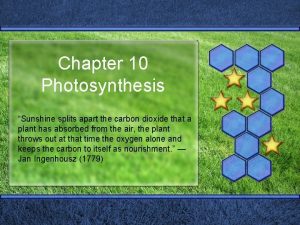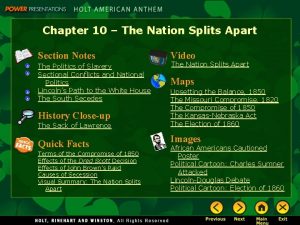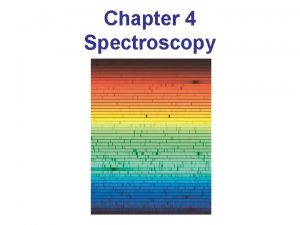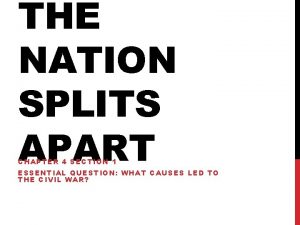1 Chapter 13 Dividends Repurchases and Splits DIVIDENDS




















































































































- Slides: 116

1 Chapter 13– Dividends, Repurchases, and Splits DIVIDENDS, REPURCHASES, AND SPLITS Chapter 13 Professor James Kuhle

2 Chapter 13– Dividends, Repurchases, and Splits Learning Objectives v. Learn about Distributions v. Learn about Dividends v. Learn about Stock Repurchases v. Learn about Stock Splits Professor James Kuhle

3 Chapter 13– Dividends, Repurchases, and Splits LO 1: Distributions v. A distribution is a payment to shareholders v. There are two main types of distributions • Dividends • Share repurchases Professor James Kuhle

4 Chapter 13– Dividends, Repurchases, and Splits Distributions v. Cash dividends • Most common distribution • Typically paid quarterly v. Stock dividends • Not cash, but additional shares in the company Professor James Kuhle

5 Chapter 13– Dividends, Repurchases, and Splits Types of Share Repurchases v. Share repurchase • The company buys back some of its shares to reduce the number of outstanding shares A company instructs its broker to buy shares on the open market at existing prices. The company makes an offer to buy a fixed quantity of shares at a fixed price. The company announces a target repurchase quantity and invites shareholders to offer their shares for sale. Professor James Kuhle

6 Chapter 13– Dividends, Repurchases, and Splits A History of Dividends and Repurchases v. Repurchases are more volatile than dividends v. Repurchase value varies with business cycle Professor James Kuhle

7 Chapter 13– Dividends, Repurchases, and Splits Yields v. Distribution Yields • Most companies (56%) have a yield of 0% • Median yield for all companies is 1. 9% Distribution Yield Professor James Kuhle

8 Chapter 13– Dividends, Repurchases, and Splits Who Makes Distributions? v. A small number of companies pay most of the dividends, and generate the most earnings Professor James Kuhle

9 Chapter 13– Dividends, Repurchases, and Splits Taxes on Dividends and Capital Gains v. Stockholders pay tax on the dividend the year the dividend is paid v 2012 tax rate for dividends Professor James Kuhle

10 Chapter 13– Dividends, Repurchases, and Splits Clienteles v. Different groups of investors that have different distribution preferences v. Prefer types of distribution with the lowest tax rate Professor James Kuhle

11 Chapter 13– Dividends, Repurchases, and Splits LO 2: Dividends v. Dividend Mechanics and Timing • Payments of dividends must be broadly disseminated by the investors • Typically done through newswire releases Announcement Date is the date the dividend is announced. Cum-Dividend date is three business days before the date of record. Ex-Dividend date is 2 business days before the date of Record. Date of Record is the day when the list of registered owners is created. Payable Date is the date the dividends are distributed to owners. Professor James Kuhle

12 Chapter 13– Dividends, Repurchases, and Splits The Impact of Dividends on the Stock Price v. Timeline of cash flows and value equation Professor James Kuhle

13 Chapter 13– Dividends, Repurchases, and Splits The Impact of Dividends on the Stock Price Professor James Kuhle

14 Chapter 13– Dividends, Repurchases, and Splits The Impact of Dividends on the Stock Price Professor James Kuhle

15 Chapter 13– Dividends, Repurchases, and Splits The Impact of Dividends on the Stock Price Professor James Kuhle

16 Chapter 13– Dividends, Repurchases, and Splits Other Factors Affecting Dividends v. Taxes • If dividend tax rates are higher than capital gain tax rates, then the price will fall by less than the amount of the dividend on the ex-dividend day v. Information Asymmetries & Signaling • Sustainable earnings • Good predictors of future earnings • Managers increase dividends when they expect higher future earnings v. Signaling hypothesis • Dividend increases should cause an increase in stock price Professor James Kuhle

17 Chapter 13– Dividends, Repurchases, and Splits Empirical Evidence About the Price Reaction of Dividends v. Dividend Decrease • One tenth the likelihood of a dividend increase • A negative market reaction is focused on dividend reductions by firms that have experienced recent decline in earnings (Note: Negative signals are stronger than positive signals because investors believe managers will exhaust all possibilities before cutting a dividend. ) v. Dividend Increase • Convey positive market information Professor James Kuhle

18 Chapter 13– Dividends, Repurchases, and Splits Dividend Policy v. Dividend decision is affected by: • The need for cash • Taxes • Asymmetric information (signaling) • Agency Problems v. Stable Dividends • Policy of keeping dividends steady • Dividends only increase IF earnings rise to a ‘sustainably’ higher level Professor James Kuhle

19 Chapter 13– Dividends, Repurchases, and Splits Dividend Policy Professor James Kuhle

20 Chapter 13– Dividends, Repurchases, and Splits Dividend Policy v. Target Payout Policy: Total Div. /Net Income (NI) • Target payout model Professor James Kuhle

21 Chapter 13– Dividends, Repurchases, and Splits Dividend Policy Professor James Kuhle

22 Chapter 13– Dividends, Repurchases, and Splits Dividend Policy v. Residual Dividend Policy • Recognizes that internal equity is a cheap source of project financing and sets dividends as a leftover • Residual dividend formula Professor James Kuhle

23 Chapter 13– Dividends, Repurchases, and Splits Dividend Policy Professor James Kuhle

24 Chapter 13– Dividends, Repurchases, and Splits LO 3: Stock Repurchases In an open market repurchase, the firm instructs it’s broker to buy share in the Open Market at the prevailing market price. The shares are then cancelled and the number of shares outstanding is reduced. v. Types of Repurchases: Professor James Kuhle

25 Chapter 13– Dividends, Repurchases, and Splits Repurchase Mechanics and Timing v. Types of repurchases (cont. ) Professor James Kuhle

26 Chapter 13– Dividends, Repurchases, and Splits Price Reactions to Stock Repurchases Professor James Kuhle

27 Chapter 13– Dividends, Repurchases, and Splits Price Reactions to Stock Repurchases • After repurchase the value of a firms equity is equal to the value of the equity before repurchase minus the cost of the repurchase • Before repurchase equity is equal to stock price times shares outstanding • The value of the equity after the repurchase • Price after repurchase Professor James Kuhle

28 Chapter 13– Dividends, Repurchases, and Splits Price Reactions to Stock Repurchases Professor James Kuhle

29 Chapter 13– Dividends, Repurchases, and Splits Price Reactions to Stock Repurchases Professor James Kuhle

30 Chapter 13– Dividends, Repurchases, and Splits Price Reactions to Stock Repurchases v. Wealth impact on repurchase v. EPS • Repurchases increase earnings per share (EPS). This is logical because you have the same level of earnings being allocated over a smaller number of shares. Professor James Kuhle

31 Chapter 13– Dividends, Repurchases, and Splits Taxes, Asymmetric Information and Agency Problems v. A debt financed repurchase will substantially change leverage v. Repurchases have been proposed as signals of future earnings v. Repurchases remove free cash flow from wasteful managers Professor James Kuhle

32 Chapter 13– Dividends, Repurchases, and Splits Stock Repurchase Policy v. Flexibility hypothesis • Repurchases do not raise expectations and implicitly commit the firm to future payouts • This gives companies more flexibility to use repurchases selectively v. Stock Options • Repurchases leave the price of stocks unchanged (initially) so may be preferred to dividend distributions • There exists a positive relationship between repurchases and management stock options Professor James Kuhle

33 Chapter 13– Dividends, Repurchases, and Splits LO 4: Stock Dividends and Splits v. Split ratio Professor James Kuhle

34 Chapter 13– Dividends, Repurchases, and Splits The Price Impact of a Stock Split v. Price after a split • is equal to the price before split divided by the number of splits • Where • PA is Price after split • PB is Price before split • S is the number of splits Professor James Kuhle

35 Chapter 13– Dividends, Repurchases, and Splits The Price Impact of a Stock Split Professor James Kuhle

36 Chapter 13– Dividends, Repurchases, and Splits The Price Impact of a Stock Split v. Example continued Professor James Kuhle

37 Chapter 13– Dividends, Repurchases, and Splits Motive for Stock Splits v. Benefits • Stock prices move to a lower trading range • Particularly relevant since stocks typically trade in board lots v. Board lot • 100 shares • Less price volatility than odd-lots • Also called a round lot v. Odd-lot • Less than one board lot Professor James Kuhle

38 Chapter 13– Dividends, Repurchases, and Splits Reverse Split v. Occurs • When a company reduces the number of shares held by each shareholder by the same proportion • The price of stock will increase v. Reasons for higher stock prices • Some stock exchanges will de-list a stock if it trades below a price of $1 for too long • Some brokerages will not lend to investors (for margin purchases) if the stock trades below a threshold price (i. e. $3) Professor James Kuhle

39 Chapter 13– Dividends, Repurchases, and Splits End of 13 Professor James Kuhle

40 Chapter 13– Dividends, Repurchases, and Splits FINANCIAL PLANNING Chapter 14 Professor James Kuhle

41 Chapter 13– Dividends, Repurchases, and Splits Learning Objectives v. Learn how to forecast sales v. Learn how to forecast cash sources and uses v. Learn how to forecast financial statements v. Learn how to manage additional funds needed Professor James Kuhle

42 Chapter 13– Dividends, Repurchases, and Splits LO 1: Sales Forecast v. Basic Sales Forecast Professor James Kuhle

43 Chapter 13– Dividends, Repurchases, and Splits Basic Sales Forecast v. Driver • An underlying economic factor that determines the future path of the variable v. Quantity Forecast • The quantity in any year t is given by Professor James Kuhle

44 Chapter 13– Dividends, Repurchases, and Splits Basic Sales Forecast Professor James Kuhle

45 Chapter 13– Dividends, Repurchases, and Splits Sales Forecast for Retailers v. Same-stores sales growth (SSSG) • The growth in sales per square foot v. SSSG Will likely rise with inflation v. Competition leads to slow price growth Professor James Kuhle

46 Chapter 13– Dividends, Repurchases, and Splits LO 2: Cash Budget v. Cash budget • Detailed statement of cash inflows and outflows Professor James Kuhle

47 Chapter 13– Dividends, Repurchases, and Splits Cash Receipts Not all sales generate immediate cash receipts. Sales and cash receipts are identical for Mammoth because everything is sold for cash at the groceries. The Sales and cash sales vary for Yingling because they extend credit terms to their buyers. Professor James Kuhle

48 Chapter 13– Dividends, Repurchases, and Splits Cash Disbursements v. Payments and inputs for supplies v. Operating expenses • Wages, rent, taxes, selling, general and administration expenses v. Capital expenditures • Purchases of fixed assets v. Financing expenses • Interest, dividends, stock repurchases, and repayment of principal Professor James Kuhle

49 Chapter 13– Dividends, Repurchases, and Splits Cash Disbursements v. Payments to suppliers • Payments to suppliers are modeled in two steps • The purchase • The payment of accounts payable Professor James Kuhle

50 Chapter 13– Dividends, Repurchases, and Splits Net Cash Flow : Cash Receipts 20% 80% Professor James Kuhle

51 Chapter 13– Dividends, Repurchases, and Splits Net Cash Flow: Cash Disbursements Professor James Kuhle

52 Chapter 13– Dividends, Repurchases, and Splits Cash Balance: Surplus or Additional Funds Needed v. Cash balance • The amount of cash in the cash account • Most firms establish a desired minimum cash balance v. Ending cash balance • The beginning balance plus the net cash flows during the month Professor James Kuhle

53 Chapter 13– Dividends, Repurchases, and Splits Cash Balance: Surplus or Additional Funds Needed Note that you carry the ending balance to the beginning of the next period. In this case, you anticipate a cash surplus and will likely invest the monies short-term. Professor James Kuhle

54 Chapter 13– Dividends, Repurchases, and Splits STOP LO 3: Financial Statements Forecasting v. Percent of Sales (POS) method • Most accounts are related to sales • Sales forecasts are used to generate forecasted statements Professor James Kuhle

55 Chapter 13– Dividends, Repurchases, and Splits Simple Forecast Professor James Kuhle

56 Chapter 13– Dividends, Repurchases, and Splits Simple Forecast v. AFN • Capital shortfall created when the balance sheet does not balance v. Plug account or plug variable • Created by adding AFN to one of the accounts • Used to make the balance sheet balance Professor James Kuhle

57 Chapter 13– Dividends, Repurchases, and Splits Forecasting Accounts Not Tied to Sales v. Interest v. Depreciation v. Capital expenditures (CAPEX) v. Net fixed assets • net and property plant and equipment Professor James Kuhle

58 Chapter 13– Dividends, Repurchases, and Splits Forecasting Accounts Not Tied to Sales v. Interest Expense • Interest expense is tied to debt rather than sales • The term (PVt-1 x 1) is the interest earned (paid) over the period t • The same equation can be used to forecast interest Professor James Kuhle

59 Chapter 13– Dividends, Repurchases, and Splits Forecasting Accounts Not Tied to Sales v. Depreciation • Depreciation expense is related to fixed assets • Declining balance depreciation system • Deducts a fixed percentage of an assets value each year Professor James Kuhle

60 Chapter 13– Dividends, Repurchases, and Splits Forecasting Accounts Not Tied to Sales v. Net Fixed Assets • When an asset is depreciated, regardless of method, the value of net fixed assets at the end of any year t is given by • When companies add fixed assets during the year (CAPEX) Professor James Kuhle

61 Chapter 13– Dividends, Repurchases, and Splits Forecasting Accounts Not Tied to Sales v. CAPEX • Capital Expenditures v. Maintenance CAPEX • Assets that are purchased to replace worn out equipment v. Growth CAPEX • Assets that must be purchased in order to grow sales Professor James Kuhle

62 Chapter 13– Dividends, Repurchases, and Splits Forecasting Accounts Not Tied to Sales Professor James Kuhle

63 Chapter 13– Dividends, Repurchases, and Splits Income Statement Forecast Professor James Kuhle

64 Chapter 13– Dividends, Repurchases, and Splits Income Statement Forecast v. Statutory rate • Taxes can be calculated using statutory rates v. Apparent tax rate • Can also be use to calculate taxes • Reflects any tax credit or special rates enjoyed by the company Professor James Kuhle

65 Chapter 13– Dividends, Repurchases, and Splits Balance Sheet Forecast v. Current Assets and Liabilities • Forecast as a percentage of sales • The turnover and payable ratios are assumed to remain constant Professor James Kuhle

66 Chapter 13– Dividends, Repurchases, and Splits Balance Sheet Forecast v. Long-Term Assets • Common long term assets include • Goodwill • Patents • Intangibles v. Debt and Equity-The Plug Variables • Not forecast as a percentage of sales • Determined as a matter of financial policy Professor James Kuhle

67 Chapter 13– Dividends, Repurchases, and Splits Balance Sheet Forecast Professor James Kuhle

68 Chapter 13– Dividends, Repurchases, and Splits LO 4: Additional Funds Needed and Growth v. The Equation Approach • Computing AFN Professor James Kuhle

69 Chapter 13– Dividends, Repurchases, and Splits Additional Funds Needed and Growth Professor James Kuhle

70 Chapter 13– Dividends, Repurchases, and Splits Additional Funds Needed and Growth v. To determine AFN • We can use forecasted financial statements • We can use the equation given earlier v. Advantages of forecasting statements • Allows for changes in relationship between sales and asset and liability accounts • It allows us to model lumpy capital expenditures, operating leverage and economies of scale Professor James Kuhle

71 Chapter 13– Dividends, Repurchases, and Splits Projecting the Maximum Internal Growth Rate v. Maximum internal growth rate (MIGR) • The highest rate that sales can grow without the firm needing additional funds • The growth that can be achieved with only internal funding v. MIGR equation • ROA is return on assets • d is the dividend payout ratio Professor James Kuhle

72 Chapter 13– Dividends, Repurchases, and Splits Maximum Internal Growth Rate Professor James Kuhle

73 Chapter 13– Dividends, Repurchases, and Splits Projecting the Maximum Sustainable Growth Rate v. Maximum sustainable growth rate (MSGR) • The highest growth that a firm can sustain using only internal equity v. MSGR Equation Professor James Kuhle

74 Chapter 13– Dividends, Repurchases, and Splits Projecting the Maximum Sustainable Growth Rate Professor James Kuhle

75 Chapter 13– Dividends, Repurchases, and Splits How to Influence Growth Rate v. Profit margin • The greater the profit on sales, the more cash is available to finance growth v. Total asset turnover • The more rapidly assets turn over the more sales are generated by each dollar of assets Professor James Kuhle

76 Chapter 13– Dividends, Repurchases, and Splits How to Influence Growth Rate v. Financial leverage • The greater percentage of debt in the firms optimal capital structure, the less equity is required to support growth v. Dividend payout ratio • The greater the net income kept by the firm to finance growth (i. e. lower dividend payout), the greater the maximum sustainable growth rate Professor James Kuhle

77 Chapter 13– Dividends, Repurchases, and Splits END OF CHAPTER 14 Professor James Kuhle

78 Chapter 13– Dividends, Repurchases, and Splits Professor James Kuhle

79 Chapter 15– The Management of Working Capital THE MANAGEMENT OF WORKING CAPITAL Chapter 15 Prof. James Kuhle

80 Chapter 15– The Management of Working Capital Learning Objectives v. Be able to calculate the operating period and cash conversion cycle to understand their roles in working capital management v. Use the economic order quantity method to compute optimal inventory level v. Understand the nature of float and how it affects a firms cash requirements v. Recognize the real cost of using trade credit v. Understand the tradeoff between different credit policies Prof. James Kuhle

81 Chapter 15– The Management of Working Capital LO 1: The Operating and Cash Conversion Cycles v. Operating period • The amount of time it takes to buy inventory, sell it, and collect on the sale • The length of the period can vary widely across industries v. Cash conversion cycle • The amount of time between when we pay for our products and when we receive payment for selling them Prof. James Kuhle

82 Chapter 15– The Management of Working Capital The Operating Period Prof. James Kuhle

83 Chapter 15– The Management of Working Capital The Operating Period v. Inventory period • The time it takes to acquire and sell the inventory v. Collection period • The time from the sale of the product until funds are actually received from the buyer Prof. James Kuhle

84 Chapter 15– The Management of Working Capital The Cash Conversion Cycle v. Accounts payable period • The time the vendor allows the firm to pay for raw materials Prof. James Kuhle

85 Chapter 15– The Management of Working Capital Calculating the Cash Conversion Cycle v. Step 1: compute the operating period • To compute operating period we need average inventory period and average collection period Prof. James Kuhle

86 Chapter 15– The Management of Working Capital Calculating the Cash Conversion Cycle v. Step 2: Calculating the cash conversion cycle Prof. James Kuhle

87 Chapter 15– The Management of Working Capital Calculating the Cash Conversion Cycle Prof. James Kuhle

88 Chapter 15– The Management of Working Capital Calculating the Cash Conversion Cycle Prof. James Kuhle

89 Chapter 15– The Management of Working Capital Calculating the Cash Conversion Cycle Prof. James Kuhle

90 Chapter 15– The Management of Working Capital Using the Cash Conversion Cycle in Working Capital Management v. Variables that impact the cash conversion cycle Prof. James Kuhle

91 Chapter 15– The Management of Working Capital LO 2: How to Manage Inventory v. Inventory represents a major asset for many firms v. Typical manufacturing firms have at least 15% of assets in inventory v. Retailers can have 25% or more of total assets in inventory Prof. James Kuhle

92 Chapter 15– The Management of Working Capital 3 types of Inventory v. Raw materials • Materials used in manufacturing process v. Work in process • Inventory that has been introduced to the manufacturing process v. Finished goods • Retailers hold goods ready to sell Prof. James Kuhle

93 Chapter 15– The Management of Working Capital Costs of Holding Inventory v. Costs of holding inventory are called carrying costs and include: • opportunity cost of funds tied up in inventory • storage costs • insurance costs • cost of obsolescence, damage, and theft v. Shortage Costs are incurred when inventory is too low and sales are missed. Prof. James Kuhle

94 Chapter 15– The Management of Working Capital Costs of Holding Inventory Prof. James Kuhle

95 Chapter 15– The Management of Working Capital Optimal Inventory v. Average inventory v. Optimal Inventory Level • Occurs when carrying cost is equal to reorder costs Prof. James Kuhle

96 Chapter 15– The Management of Working Capital Computing the Economic Order Quantity v. Economic order quantity (EOQ) model • Best known and simplest method to compute optimal inventory level Prof. James Kuhle

97 Chapter 15– The Management of Working Capital Computing the Economic Order Quantity v. Economic order quantity (EOQ) model • Best known and simplest method to compute optimal inventory level Prof. James Kuhle

98 Chapter 15– The Management of Working Capital Computing the Economic Order Quantity Prof. James Kuhle

99 Chapter 15– The Management of Working Capital Computing the Economic Order Quantity v. Adding a safety stock • A minimum level of inventory a firm keeps on hand • Ideally inventory will only fall below this level in emergencies Prof. James Kuhle

100 Chapter 15– The Management of Working Capital Other Inventory Methods v. Basket method • Inventory is separated into three bins (baskets) when it arrives • The first bin is the normal operating inventory • When the first bin is empty, new inventory is ordered and the firm operates out of the second bin • The third bin is the safety stock Prof. James Kuhle

101 Chapter 15– The Management of Working Capital Other Inventory Methods v. Just in time inventory method • An alternative to holding inventory • Parts and supplies are delivered just as the firm needs them • This method increases the likelihood of stockout Prof. James Kuhle

102 Chapter 15– The Management of Working Capital LO 3: How to Manage Accounts Receivable v. Accounts receivable turnover ratio v. Average collection period v. Why credit is offered • Offering credit stimulates sales • Trade credit is very common in many industries Prof. James Kuhle

103 Chapter 15– The Management of Working Capital Developing a Credit Policy v. Credit policy • Stipulates how a firm will handle each phase of the credit decision • This includes what goods will be sold on credit v. Three elements of the typical credit sale: • Credit period • Discount amount • Discount period Prof. James Kuhle

104 Chapter 15– The Management of Working Capital Developing a Credit Policy v. Credit period • The length of time the customer has before payment is due • Varies among industries • Typically between 30 and 120 days v. Inventory period • The length of time it takes the buyer to acquire, process and sell the inventory v. Receivable cycle • The length of time it takes to collect on a sale Prof. James Kuhle

105 Chapter 15– The Management of Working Capital Developing a Credit Policy v. Factors to consider when establishing a credit policy • Consumer demand for the product • Whether the product is perishable or has continuing collateral value • The credit risk of the buyer • The competition in the market. v. The effective annual rate for taking a cash discount • Cash discounts are used to speed up the collection of accounts receivable • Usual terms offer a 1% or 2% discounts for paying the balance within a short period Prof. James Kuhle

106 Chapter 15– The Management of Working Capital Developing a Credit Policy v. Effective interest rate (EIR) Prof. James Kuhle

107 Chapter 15– The Management of Working Capital Developing a Credit Policy v. Cost of credit includes three factors • Cost of holding increased current assets • Bad debt losses • Cost of administering the accounts receivable Prof. James Kuhle

108 Chapter 15– The Management of Working Capital Developing a Credit Policy v. Five Cs of credit analysis • Character • The willingness of the borrower to pay obligations owed • Capacity • The ability of the borrower to pay • Capital • The financial reserves of the firm • Conditions • The general economic and business climate • Collateral • The value of the assets that could be seized if the customer doesn’t pay on the debt Prof. James Kuhle

109 Chapter 15– The Management of Working Capital Developing a Credit Policy v. Collection of accounts receivable (monitoring) • Collection policy begins with careful monitoring of accounts receivable v. Monitoring accounts receivable • Average collection period • Tells managers how long the average credit remains outstanding • Important ratio used to track accounts receivable Prof. James Kuhle

110 Chapter 15– The Management of Working Capital Developing a Credit Policy v. Aging schedule • Another tool mangers use to evaluate the firms accounts receivable v. Collection effort • The firm follows a sequence of progressively more insistent steps Prof. James Kuhle

111 Chapter 15– The Management of Working Capital LO 4: How to Manage Cash v. Disbursement float • Occurs when there’s a delay between when the firm issues a check and when the funds are removed from the checking account v. Collection float • Occurs when there’s a delay between when you receive payment and when the bank gives you credit v. Net float • Net float is the difference between available balance and book balance Prof. James Kuhle

112 Chapter 15– The Management of Working Capital Electronic Funds Transfer (EFT) v. EFT • Broad term that refers to the transfer of funds around the world electronically, as opposed to a paper document Prof. James Kuhle

113 Chapter 15– The Management of Working Capital Computing the Optimal Cash Balance v. Reasons to hold cash • Transactional motive • The need to pay debts • Precautionary motive • The need for a safety supply to act as a financial reserve • Speculative motive • The need to take advantage of bargain purchases or opportunities that arise Prof. James Kuhle

114 Chapter 15– The Management of Working Capital LO 5: Short Term Financing Alternatives v. Bank Loans • Supply short term funds needed for the firms operation • The bank can charge fees • The firm can be more flexible Prof. James Kuhle

115 Chapter 15– The Management of Working Capital Short Term Financing Alternatives v. Self Liquidating Loans • The loan is made to finance an asset that will pay off the loans • Receivable financing • Requires the firm to pledge its accounts receivable to the bank as collateral • Inventory financing • The firm borrows a portion of the value of its inventory Prof. James Kuhle

116 Chapter 15– The Management of Working Capital Short Term Financing Alternatives v. Lines of Credit • The total amount that can be borrowed is the firm’s line of credit • Little effort is required by the firm to obtain a disbursement of funds Prof. James Kuhle
 The bone is bent and splits causing an incomplete break.
The bone is bent and splits causing an incomplete break. Artificial defects in wood
Artificial defects in wood The nation splits
The nation splits Net profit after tax and preference dividends
Net profit after tax and preference dividends Private activity bond interest dividends
Private activity bond interest dividends Dividends of workplace diversity
Dividends of workplace diversity Record date ex dividend date
Record date ex dividend date Acct 100
Acct 100 Journal entry stock dividend
Journal entry stock dividend Dmsbr
Dmsbr Record the closing entry for dividends.
Record the closing entry for dividends. Homemade dividends
Homemade dividends The information content of dividends refers to
The information content of dividends refers to Chapter 7 ionic and metallic bonding chapter answer key
Chapter 7 ionic and metallic bonding chapter answer key Chapter 7 ionic and metallic bonding answer key
Chapter 7 ionic and metallic bonding answer key Chapter 7 chapter assessment ionic compounds and metals
Chapter 7 chapter assessment ionic compounds and metals 7 ionic and metallic bonding practice problems
7 ionic and metallic bonding practice problems Tetraphosphorus octoxide formula
Tetraphosphorus octoxide formula Red tent summary
Red tent summary Chapter eight the great gatsby
Chapter eight the great gatsby Chapter 10 chemical reactions
Chapter 10 chemical reactions Chapter 11 stoichiometry study guide answer key
Chapter 11 stoichiometry study guide answer key Chapter 9 chemical reactions answers
Chapter 9 chemical reactions answers Chapter 7 similarity chapter test form a answer key
Chapter 7 similarity chapter test form a answer key Chapter 6: career readiness
Chapter 6: career readiness Chapter 9 surface water chapter assessment answer key
Chapter 9 surface water chapter assessment answer key Physics chapter 2 representing motion assessment answers
Physics chapter 2 representing motion assessment answers Chemistry: the central science chapter 14 answers
Chemistry: the central science chapter 14 answers Chapter 4 population ecology section 1 population dynamics
Chapter 4 population ecology section 1 population dynamics Chapter 2 chapter assessment
Chapter 2 chapter assessment Book of philippians background
Book of philippians background What role do automobiles play in the great gatsby
What role do automobiles play in the great gatsby The giver chapter 3 and 4 questions and answers
The giver chapter 3 and 4 questions and answers Diversity and human needs and development
Diversity and human needs and development Motivating and satisfying employees and teams
Motivating and satisfying employees and teams Bridge to terabithia chapter 4 pdf
Bridge to terabithia chapter 4 pdf Chapter 3 animal farm quiz
Chapter 3 animal farm quiz Chapter 24 the immune and lymphatic systems and cancer
Chapter 24 the immune and lymphatic systems and cancer The mouse and the motorcycle chapter questions and answers
The mouse and the motorcycle chapter questions and answers Chapter 4 section 1 work and machines answer key
Chapter 4 section 1 work and machines answer key Chapter 10 motivating and satisfying employees and teams
Chapter 10 motivating and satisfying employees and teams The lymphatic capillaries are
The lymphatic capillaries are Red orange yellow green blue purple
Red orange yellow green blue purple World war 1 and the russian revolution chapter 27
World war 1 and the russian revolution chapter 27 Chapter 10 section 2 central america and the caribbean
Chapter 10 section 2 central america and the caribbean Work measurement techniques
Work measurement techniques Unit 14 lesson 1 drivers ed
Unit 14 lesson 1 drivers ed Chapter 9 adhesives gluing and clamping answer key
Chapter 9 adhesives gluing and clamping answer key Why study financial markets and institutions chapter 1
Why study financial markets and institutions chapter 1 Chapter 20 weather patterns and severe storms
Chapter 20 weather patterns and severe storms Mechanical waves
Mechanical waves The wave chapter 14
The wave chapter 14 Walk two moons chapter questions
Walk two moons chapter questions Types of interior displays
Types of interior displays Chapter 14 vibrations and waves
Chapter 14 vibrations and waves Chapter 30 fishes and amphibians worksheet answers
Chapter 30 fishes and amphibians worksheet answers Properties and attributes of triangles
Properties and attributes of triangles Chapter 28 human systems and homeostasis
Chapter 28 human systems and homeostasis Chapter 9 motion and energy answer key
Chapter 9 motion and energy answer key Shifters of supply
Shifters of supply Chapter 3 lesson 3 expressing emotions in healthful ways
Chapter 3 lesson 3 expressing emotions in healthful ways Unit 14:7 measuring and recording blood pressure
Unit 14:7 measuring and recording blood pressure Chapter 37 respiration circulation and excretion
Chapter 37 respiration circulation and excretion Protection support and locomotion answer key
Protection support and locomotion answer key How is the hts regulated
How is the hts regulated Turmoil and change in mexico
Turmoil and change in mexico Tsotsi chapter 3 questions and answers
Tsotsi chapter 3 questions and answers Who gave cole the at.oow blanket
Who gave cole the at.oow blanket Touching spirit bear chapter 10
Touching spirit bear chapter 10 Touching spirit bear chapter 20
Touching spirit bear chapter 20 Measuring instrument
Measuring instrument Ch 23 tkam
Ch 23 tkam Things fall apart summary chapter 4-6
Things fall apart summary chapter 4-6 Things fall apart ch 17
Things fall apart ch 17 Acowar chapter 14
Acowar chapter 14 Whats vietnamization
Whats vietnamization Chapter 14 the sixties a decade of protest and change
Chapter 14 the sixties a decade of protest and change What does ponyboy decide to write for his english project?
What does ponyboy decide to write for his english project? The lion the witch and the wardrobe chapter 13 summary
The lion the witch and the wardrobe chapter 13 summary What does crusty sell in percy jackson
What does crusty sell in percy jackson Percy jackson and the lightning thief chapter 12 summary
Percy jackson and the lightning thief chapter 12 summary Chapter 11 percy jackson the lightning thief
Chapter 11 percy jackson the lightning thief The lightning thief chapter 6
The lightning thief chapter 6 Chapter 2 the lightning thief
Chapter 2 the lightning thief Chapter 24 the land where continents collided
Chapter 24 the land where continents collided Hunger games chapter 3
Hunger games chapter 3 What is katniss’ prediction as she readies herself?
What is katniss’ prediction as she readies herself? Great gatsby chapter 1 quiz
Great gatsby chapter 1 quiz The great gatsby chapter 6 quiz
The great gatsby chapter 6 quiz Foreshadowing in chapter 7 of the great gatsby
Foreshadowing in chapter 7 of the great gatsby The great gatsby chapter 3 short summary
The great gatsby chapter 3 short summary Summary of the giver chapter 7
Summary of the giver chapter 7 Zhamate
Zhamate Hepatic portal system
Hepatic portal system Chapter 21 temperature heat and expansion answer key
Chapter 21 temperature heat and expansion answer key System analysis and design chapter 2
System analysis and design chapter 2 Linux operation and administration chapter 8
Linux operation and administration chapter 8 Drivers of supply chain management
Drivers of supply chain management Noughts and crosses chapter 1 summary
Noughts and crosses chapter 1 summary Chapter 11 section 2 stream and river deposits answer key
Chapter 11 section 2 stream and river deposits answer key Statistics for business and economics chapter 6 solutions
Statistics for business and economics chapter 6 solutions Accel entertainment jobs
Accel entertainment jobs Chapter 6 prices and decision making assessment answers
Chapter 6 prices and decision making assessment answers Chapter 21 section 1 landforms and resources
Chapter 21 section 1 landforms and resources Sound and sense chapter 1 answers
Sound and sense chapter 1 answers Chapter 10 somatic and special senses
Chapter 10 somatic and special senses Signals and systems oppenheim solutions chapter 5
Signals and systems oppenheim solutions chapter 5 Chapter 12 sequences and series answers
Chapter 12 sequences and series answers Chapter 13 exercise and lifelong fitness
Chapter 13 exercise and lifelong fitness Chapter 6 safety and body mechanics
Chapter 6 safety and body mechanics Chapter 18 responsibilities and costs of credit
Chapter 18 responsibilities and costs of credit 21 rehabilitation and restorative care
21 rehabilitation and restorative care Chapter 22 regulatory and advisory agencies
Chapter 22 regulatory and advisory agencies Chapter 29 reflection and refraction
Chapter 29 reflection and refraction Refraction of sound
Refraction of sound Chapter 17 reflection and mirrors
Chapter 17 reflection and mirrors Chapter 10 racial and ethnic relations
Chapter 10 racial and ethnic relations
